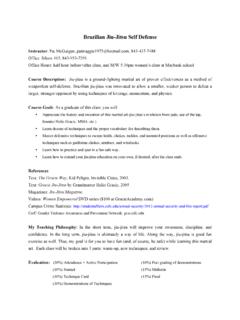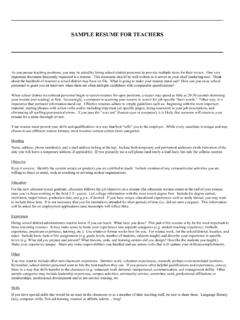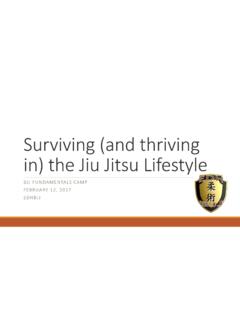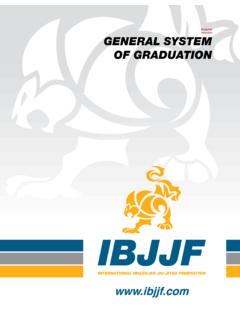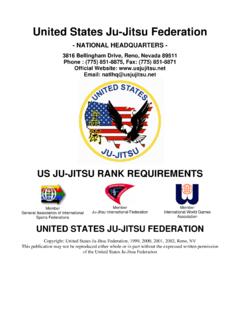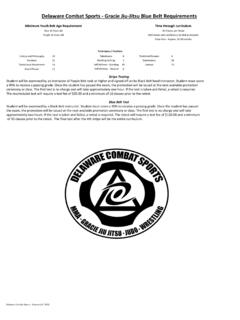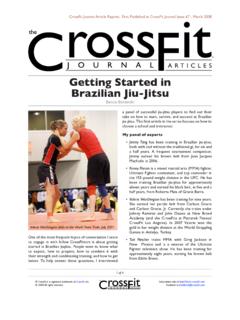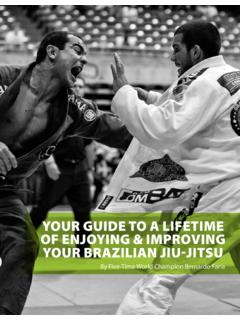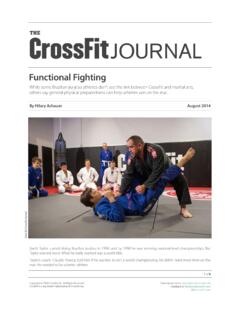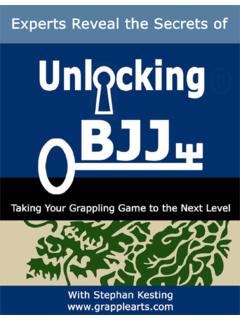Transcription of Gracie Jiu-Jitsu Jiu-Jitsu Magazine
1 College of Charleston PEAC 120-09 Introduction to Brazilian Jiu-Jitsu for Women s Self-Defense Spring 2016 2 Semester Hours Location: TR, Silcox Center, 2nd Floor Gym Instructors: Pat McGuigan and John Venable Office: n/a Contact: Pat: 843-437-7488, John: 843-345-2902, Office Hours: before and after class and by appointment. Prerequisites: None Grading: A, A-, B+, B, B-, C+, C, C-, D+, D, D- and F. Course Description: This course is designed to cover a variety of topics not otherwise offered in the basic physical education activity program. Popular activities representing both traditional and non-traditional activities will be offered on a random basis according to interest shown in the activity.
2 Brazilian Jiu-Jitsu Description: Jiu-Jitsu is a ground-fighting martial art of proven effectiveness as a method of weaponless self-defense. Brazilian Jiu-Jitsu was innovated to allow a smaller, weaker person to defeat a larger, stronger opponent by using techniques of leverage, momentum, and physics. Suggested References: Gracie Jiu-Jitsu by Grandmaster Helio Gracie , 2005. Jiu-Jitsu Magazine . Video: YouTube Helio Gracie Documentary with subtitles (captions on ) Campus Crime Statistics: CofC Gender Violence Awareness and Prevention Network: Course Objectives: As a graduate of this class, you will: Appreciate the history and invention of this martial art ( Jiu-Jitsu s evolution from judo, use of the tap, founder Helio Gracie , MMA, etc.)
3 Learn dozens of techniques and the proper vocabulary for describing them. Master defensive techniques to escape holds, chokes, tackles, and mounted positions as well as offensive techniques such as guillotine chokes, armbars, and wristlocks. Learn how to practice and spar in a fun safe way. Learn how to extend your Jiu-Jitsu education on your own, if desired, after the class ends. Student Learning Outcomes: As a graduate of this class, you will: 1. be able to identify at least 4 key figures in this martial art. Students will watch documentaries and this outcome will be assessed on the written exams. 2. be able use the proper vocabulary associated with techniques and key positions in the hierarchy of positions.
4 This will be assessed with written exams and journal assignments. 3. be able to demonstrate over 40 techniques, both offensive and defensive. This will be assessed on the practical exams during which an instructor will simulate a real attack against the student who must correctly demonstrate each technique. 4. be able to practice with partners in a fun and safe manner. This will be assessed in daily partner drills. 5. understand what resources are available for you to continue your Jiu-Jitsu journey. This will be assessed with several questions on the final exam as well as informally with an exit conversation with an instructor. Our Teaching Philosophy: In the short term, Jiu-Jitsu will improve your awareness, discipline, and confidence.
5 In the long term, Jiu-Jitsu is ultimately a way of life. Along the way, Jiu-Jitsu is good fun exercise as well. Thus, our goal is for you to have fun (and, of course, be safe) while learning this martial art. Each class will be broken into 3 parts: warm-up, drills, and new techniques. Description of Projects: Written Exams There will be two written exams: one at midterm and one cumulative final exam. The exams will cover techniques, history, philosophies, and principles of Brazilian Jiu-Jitsu . Practical Exams There will be two practical exams: one at midterm and one cumulative final exam. A practical exam tests a student s ability to do the techniques in a live setting with an instructor acting as the attacker.
6 Prior to each practical exam, students will be explained how each exam will be graded and will be encouraged to film the instructors demonstrating and narrating the entire practical exam to use as a study guide. Personalized individual feedback will be given to each student immediately after the practical exam. The Technique Card handed out on Day 1 and copied on p. 3 of this syllabus shows the order in which the techniques will be taught. Techniques on Side 1 of the card will be tested on the practical midterm exam. Techniques on both sides of the card will be tested on the practical final exam. Journal - Students will keep a journal throughout the semester. The journal should contain notes on each technique learned and can be used as a way to brush up on techniques long after the class has finished, for example, to prepare for a study abroad semester.
7 The journal should also contain observations that a student makes about his or her progress and the possible impact of Jiu-Jitsu on other classes or interactions. In addition, the journal should be used as a place to list key vocabulary for Jiu-Jitsu . See the Vocabulary List at the end of this syllabus. We recommend that you write in your journal immediately after each class. Attendance and Participation: Techniques are best learned in pairs with one person playing the attacker and the other, the defender. Thus, your attendance affects not only you, but also your classmates. Attend every class and participate actively. Your final grade will drop a letter grade for every 2 classes you miss. No distinction is made between excused and unexcused absences.
8 Criteria for Evaluation: Attendance and Active Participation 20% Being a Good Partner 20% Journal 10% Written Midterm 10% Practical Midterm 15% Written Final 10% Practical Final 15% ---------------------------------------- --------------------------------------- Total 100% Grading Scale: A = 93-100% B- = 80-82% D+ = 70-71% A- = 90-92% C+ = 78-79% D = 68-69% B+ = 88-89% C = 74-77% D- = 66-67% B = 83%-87% C- = 72-73% F = < 66% Bonus Points: Opportunities for bonus points may be announced during the semester.
9 Make-up Tests: No make-ups will be given. Skills are accessed periodically during 2-day periods. If a student is absent both days no skill make-ups will be granted. Texting: All cellular devices must be turned off prior to class. Texting in class or checking one s phone will result in a 20% per occurrence reduction in one s Participation grade. Proper Attire: gi pants and shirt with shoulders/sleeves and no jewelry Hygiene: Jiu-Jitsu is practiced in very close contact. Respect your classmates wear clean clothes and smell good. Safety: While executing techniques, you will be in close contact with your classmates. Thus, both your and your classmates safety is a priority. One great advantage of Jiu-Jitsu is that it can be practiced at full speed and strength right up until the moment of submission.
10 The tap enables this. With the tap, one student signals another that the move was effective and should be stopped. Continue past the moment of the tap and someone could get injured. Because this martial art focuses on joint manipulations, it is important to learn to (1) tap quickly and (2) to respect others taps. Student Responsibilities regarding Equipment: Jiu-Jitsu contains many ground techniques and is practiced on mats. Each class the mats must be setup and used, then cleaned and returned to storage. Honor System: Students must do their own work. Please see the 2014- 2015 Student Handbook (Academic Honor System) for a description of the College s Honor System, which is fully supported in this class. Students can find the complete Honor Code and all related processes in the Student Handbook at Disability Policy: This College abides by section 504 of the Rehabilitation Act of 1973 and the Americans with Disabilities Act that stipulates no student shall be denied access to an education solely by reason of a handicap.
